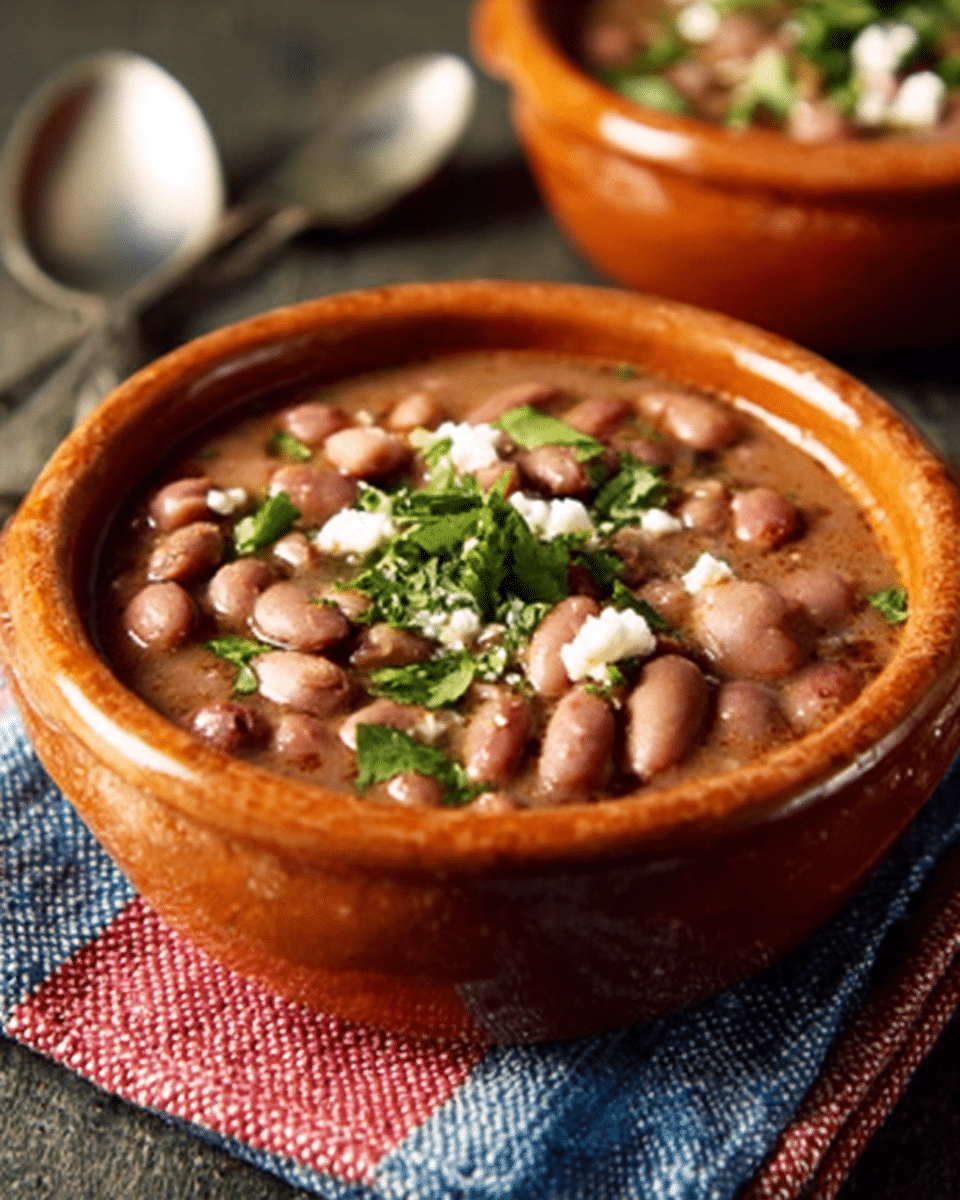Frijoles de Olla is a traditional Mexican bean stew known for its simple, hearty, and wholesome qualities. This dish features whole pinto or black beans slowly simmered in water with aromatics like onion, garlic, and epazote, resulting in a flavorful broth that is both nourishing and comforting.
FULL RECIPE
Ingredients
- 2 cups dried pinto beans (or black beans)
- 8 cups water
- 1 medium white onion, peeled and halved
- 3 cloves garlic, peeled
- 2 sprigs fresh epazote (or 1 tsp dried epazote)
- 1 tsp salt (adjust to taste)
- Optional: 1 bay leaf
Directions
- Rinse the dried beans thoroughly under cold running water and remove any debris or damaged beans.
- In a large pot or Dutch oven, combine the rinsed beans with water, onion halves, garlic cloves, epazote, and bay leaf if using.
- Bring the mixture to a boil over high heat, then reduce the heat to low and let it simmer uncovered.
- Cook for approximately 1.5 to 2 hours, or until the beans are tender but not falling apart. Stir occasionally and skim off any foam that forms on the surface.
- Once the beans are cooked, remove the onion, garlic, bay leaf, and epazote sprigs.
- Season the beans with salt, stirring gently to combine. Adjust salt to taste.
- Serve hot as a stew or use the beans and broth as a base for other Mexican dishes.
Nutrition Facts
- Calories: 180
- Protein: 12 g
- Fat: 1 g
- Saturated Fat: 0 g
- Carbohydrates: 32 g
- Fiber: 9 g
- Sugars: 1 g
- Sodium: 300 mg
- Cholesterol: 0 mg
Cultural Importance of Frijoles de Olla
Frijoles de Olla is a cornerstone of Mexican cuisine, deeply rooted in the country’s history and daily life. This bean stew has been a dietary staple for centuries, providing affordable nourishment for families across generations. It often symbolizes sustenance and community, especially during national celebrations like Mexican Independence Day, where sharing food embodies togetherness and pride. Its presence in Mexican households extends beyond just a meal—it is part of the cultural fabric, representing simplicity, tradition, and the essence of home cooking.
Flavor and Texture Characteristics
The flavor of Frijoles de Olla is mild yet rich, thanks to the slow simmering of beans with aromatic ingredients such as onion, garlic, and epazote—a traditional herb that imparts a distinctive earthy and slightly medicinal note. The broth is soothing and savory, with the beans tender but intact, providing a pleasing contrast in texture. This stew is comforting without being heavy, and the clean flavors allow it to complement a wide variety of side dishes and seasonings. Its subtle taste also makes it an excellent canvas for customization with additional spices or toppings.
Nutritional Benefits
Frijoles de Olla is a nutritional powerhouse, offering an excellent source of plant-based protein, dietary fiber, and essential vitamins and minerals. Beans are well-known for their ability to support heart health, regulate blood sugar, and promote digestive wellness. The high fiber content contributes to prolonged satiety and aids in maintaining a healthy weight. Moreover, the beans contain antioxidants and phytochemicals that help reduce inflammation. This stew is naturally low in fat and cholesterol-free, making it suitable for various dietary preferences and health goals.
Regional and Ingredient Variations
While the traditional recipe centers on pinto or black beans, regional variations abound depending on local preferences and ingredient availability. Some cooks add additional vegetables like chayote, carrots, or tomatoes to enrich the stew. Epazote is a classic herb often included to reduce the beans’ natural gas-producing effects and to add flavor, but it can be substituted with other herbs like cilantro or oregano if unavailable. In some areas, pork rinds or bacon may be added for a heartier version, while others keep it strictly vegetarian or vegan. These variations highlight the stew’s adaptability across Mexico’s diverse culinary landscape.
Serving Suggestions and Pairings
Frijoles de Olla is often served as a main dish accompanied by fresh corn tortillas, rice, or warm bread to soak up the flavorful broth. It pairs wonderfully with Mexican staples like grilled meats, eggs, or sautéed vegetables. Popular accompaniments include chopped onions, salsa, avocado slices, and crumbled queso fresco to add texture and flavor contrast. For a complete meal, it can be served alongside a fresh salad or pickled vegetables, creating a balanced plate that celebrates Mexican flavors and nutrition.
Health-Conscious Preparation Tips
Preparing Frijoles de Olla in a health-conscious way involves minimizing added fats and controlling sodium content. Using homemade broth or water instead of commercial broths can significantly reduce sodium levels. Skimming foam and excess starch during cooking helps achieve a clearer broth and lighter texture. For those watching carbohydrate intake, pairing the stew with fiber-rich vegetables or a side salad can help balance the meal. Additionally, soaking beans overnight before cooking not only reduces cooking time but may also improve digestibility and nutrient absorption.
Storage and Reheating Guidelines
Frijoles de Olla keeps well refrigerated for up to four days, making it ideal for meal prepping or leftovers. To preserve its texture, store the beans in an airtight container and reheat gently over low heat, adding a splash of water or broth if necessary to loosen the stew. This helps prevent the beans from becoming too thick or dry. It can also be frozen for up to two months, but beans may soften further upon thawing. To maintain the best flavor and consistency, it’s recommended to consume frozen portions within one month.
Common Mistakes to Avoid
One frequent mistake is cooking the beans too quickly or at too high a temperature, which can cause them to burst and turn mushy instead of tender but intact. It’s important to simmer gently and avoid boiling vigorously. Another error is neglecting to soak the beans beforehand, which can increase cooking time and cause uneven texture. Over-salting too early can also toughen the beans, so salt should be added toward the end of cooking. Lastly, skipping the epazote or a similar herb can result in a less flavorful stew and may increase digestive discomfort for some people.
Incorporating Frijoles de Olla into a Balanced Diet
Frijoles de Olla is an excellent dish for those looking to include more plant-based meals in their diet without sacrificing flavor or satisfaction. Its high protein and fiber content promote fullness and energy, making it a great option for vegetarians and vegans. Paired with whole grains and fresh vegetables, it can form the foundation of balanced meals that support overall health. Because it is filling yet low in fat, it fits well into weight management and heart-healthy eating plans.
Advertisement
Conclusion
Frijoles de Olla is more than just a simple bean stew—it is a nourishing dish steeped in Mexican tradition that offers comfort, nutrition, and versatility. Its straightforward preparation and wholesome ingredients make it accessible for cooks of all skill levels, while its rich history and cultural significance enrich the dining experience. Whether enjoyed as a heartwarming meal on its own or as a foundation for other recipes, this classic stew exemplifies the power of humble ingredients transformed into something deeply satisfying and meaningful.






